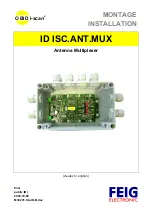
SAFETY INFORMATION: Always read before proceeding.
WARNING
These instructions contain information and warnings that are necessary for safe
operation and maintenance of the MM37. It is recommended that you read the
instructions carefully and ensure the contents are understood. Failure to
understand the instructions and comply with warnings and instructions herein
can result in serious injury, damage or even death.
In order to avoid the danger of electrical shock, it is important that proper safety
measures are taken when working with voltages exceeding 30V AC rms, 42V AC
peak or 60V DC. Never exceed the maximum allowable input level for each
function and range. Refer to the specifications for maximum inputs. Never
touch exposed wiring, connections or live circuits.
The MM37 must only be used in conditions and for the purpose which it has
been constructed. Attention should be paid to safety instructions, technical
specifications and use of the MM37 in dry surroundings.
Always inspect your meter, test leads and accessories for any sign of damage
before use. If any abnormal conditions exist (e.g: broken test leads, cracked
case, display not reading, etc.), do not attempt to use it. Do not expose it to
direct sunlight, excessive temperature or moisture.
Keep these instructions for future reference. Updated instructions and product
information are available at: www.martindale-electric.co.uk.
SYMBOLS:
Equipment complies with relevant EU Directives
AC (Alternating Current)
Ground
Direct Current
Equipment protected by Double Insulation (Class II)
Caution - refer to accompanying documents
Caution - risk of electric shock
4. MAINTENANCE
4.1 Cleaning
Maintenance consists of periodic cleaning and battery replacement.
The exterior of the instrument can be cleaned with a dry clean cloth to
remove any oil, grease or grime. Never use liquid solvents or detergents.
Repairs or servicing not covered in this manual should only be performed
by qualified personnel.
4.2 Battery Replacement
WARNING - To avoid electrical shock, disconnect the test leads and
any input signals before replacing the battery. Replace only with the
same type of battery.
This meter is powered by NEDA type 1604 or equivalent 9V battery. When
the meter displays the “ ” symbol, the battery must be replaced to
maintain proper operation. To replace the battery, remove the three screws
from the back of the meter and open the bottom case, remove the battery
from battery compartment and replace it with a new one.
4.3 Fuse Replacement
If no current measurements are possible, check for a blown overload
protection fuse. There are two fuses: F1 for the µA/mA socket and F2 for
the 10A socket. For access to fuses, remove the three screws from the
back of the meter and open the bottom case. Replace F1 only with the
original type 0.5A/250V, fast acting fuse (part no: FUSE500250).
Replace F2 only with the original type 10A/600V, fast acting ceramic fuse
(part no: FUSE10600).
4.4 Calibration
The recommended calibration interval is 12 months.
2
11
























